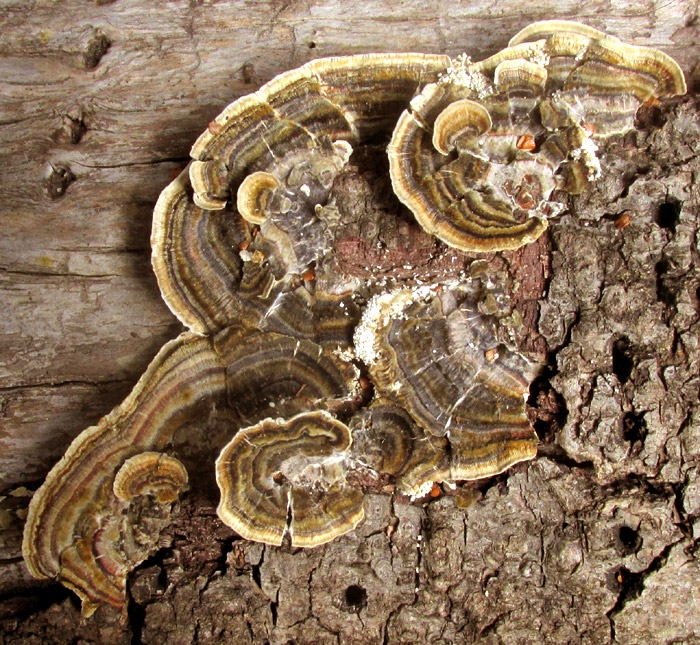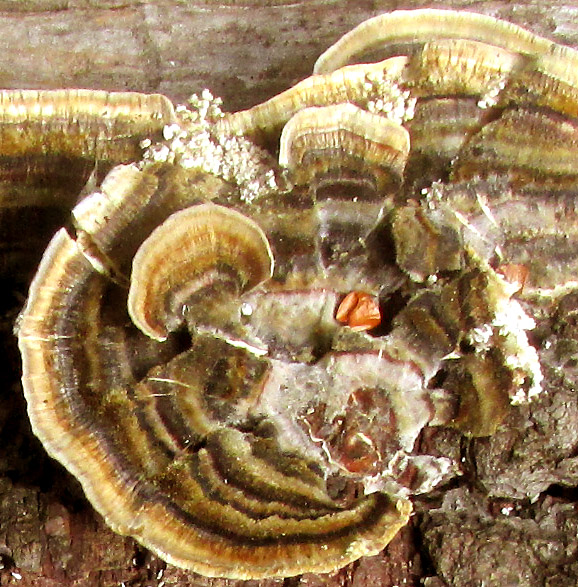Excerpts from Jim Conrad's
Naturalist Newsletter
Entry dated November 9, 2023, from notes taken near Cascadas de La Piedad waterfall 3kms NW of the community of San Pablo, municipality of Almeaco de Bonfil; in canyon of La Piedad below the falls; N20.1017°, W100.0041°, elevation 2360 meters (7750ft); extreme southern Querétaro state, MÉXICO
TURKEY TAIL

Lying in a semi-open spot on the canyon floor, a pine tree trunk hosted the above Turkey Tail fungus. Turkey Tails are among the Earth's most commonly occurring and best known fungi; sometimes different but similar species are known by that name. Up North, Turkey Tails are thought of as inhabiting trunks of deciduous trees, but certain strains do thrive on pine.

Above, scattered on both the fruiting body and in log cracks, note the tiny white bodies and diffuse areas of whiteness. The Turkey Tail's "working part" lies inside the trunk. It's composed of white, thread-like hyphae growing through the dead wood, decomposing it and feeding on the released nutrients. Once the hyphal network is large and complex enough, and environmental factors such as temperature and humidity are right, the hyphae gather, interact, and emerge at the trunk's surface. At first they're like very small and look like minuscule polystyrene balls; they're called hyphal knots, and clusters of them appear above. More development may lead to somewhat larger, upward projecting, fingerlike projections called primordia. Even larger structures beginning to develop pigment and color are called pins. Gradually the spore-producing Turkey Tail fruiting body becomes recognizable. Above, various stages of the process are seen, some of which may be aborted, and some of which may lead to new fruiting bodies.

The above undersurface of a severed part of a cap shows conspicuous pores on the undersurface, from which reproductive spores will fall. If the surface had been smooth, our fungus would have been a very unrelated "False Turkey Tail." There's nothing "truer" about one species than the other; it's just that that's how the names have come to be known in English. In the above picture, the torn area exposes the cottony hyphae of which the cap is made.
Our Turkey Tail, which is a "true" one, is TRAMETES VERSICOLOR, and it occurs worldwide. It's a white-rot form of wood-decay fungus, whose hyphae inside dead wood produce enzymes that digest the wood, releasing nutrients the fungus needs for survival.
Turkey Tails are too tough to eat, but they have a long history of traditional medicinal use worldwide. The online Atlas de las Plantas de la Medicina Tradicional Mexicana, which uses Turkey Tail's older scientific name of Coriolus versicolor, reports that around the town of Acambay, México state, the dry mushroom is crushed with water or milk to serve as a purgative -- cause vomiting. In the Sierra de Puebla mountain area, the porous undersurface is rubbed over the skin to cure itching, hot and scaling places, usually on the face, as well as on discolored skin blotches.
On the Internet, Turkey Tail apparently is sold in great quantities for herbal medicinal use and as a dietary supplement. Often the claims of what the fungus is used for is vague or simply not stated, but in the 2020 study by Solomon Habtemariarm entitled "Trametes versicolor (Synn. Coriolus versicolor) Polysaccharides in Cancer Therapy: Targets and Efficacy," writes that derivatives of the fungus, mostly produced in China and Japan and known as PSP and PSK, have been claimed to be helpful for treating cancer. The author writes, "Overall, the polysaccharides of C. versicolor have been shown to induce direct cell growth inhibitory effect and apoptosis in cancer cells." In other words, the derivatives have been shown in lab studies to slow down and kill (apoptosis) cancer cells.